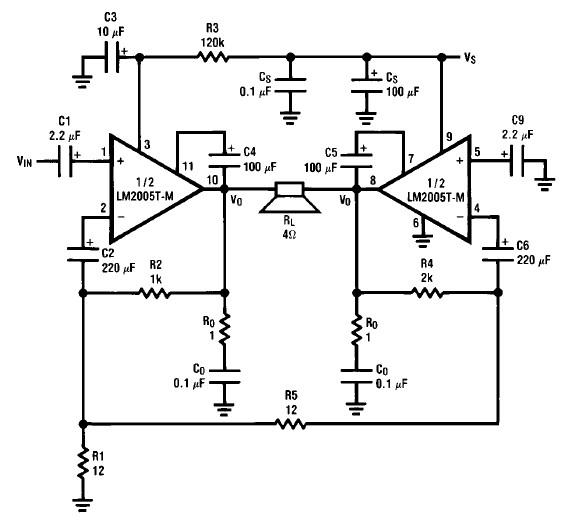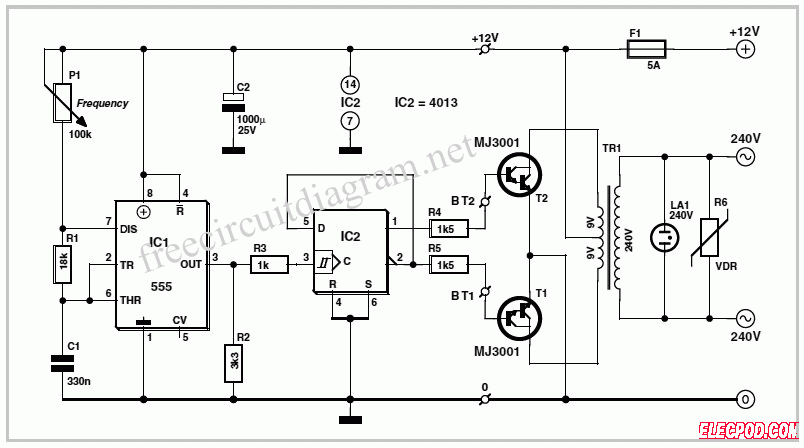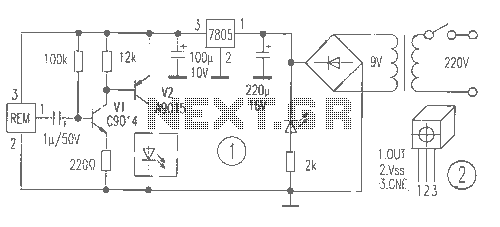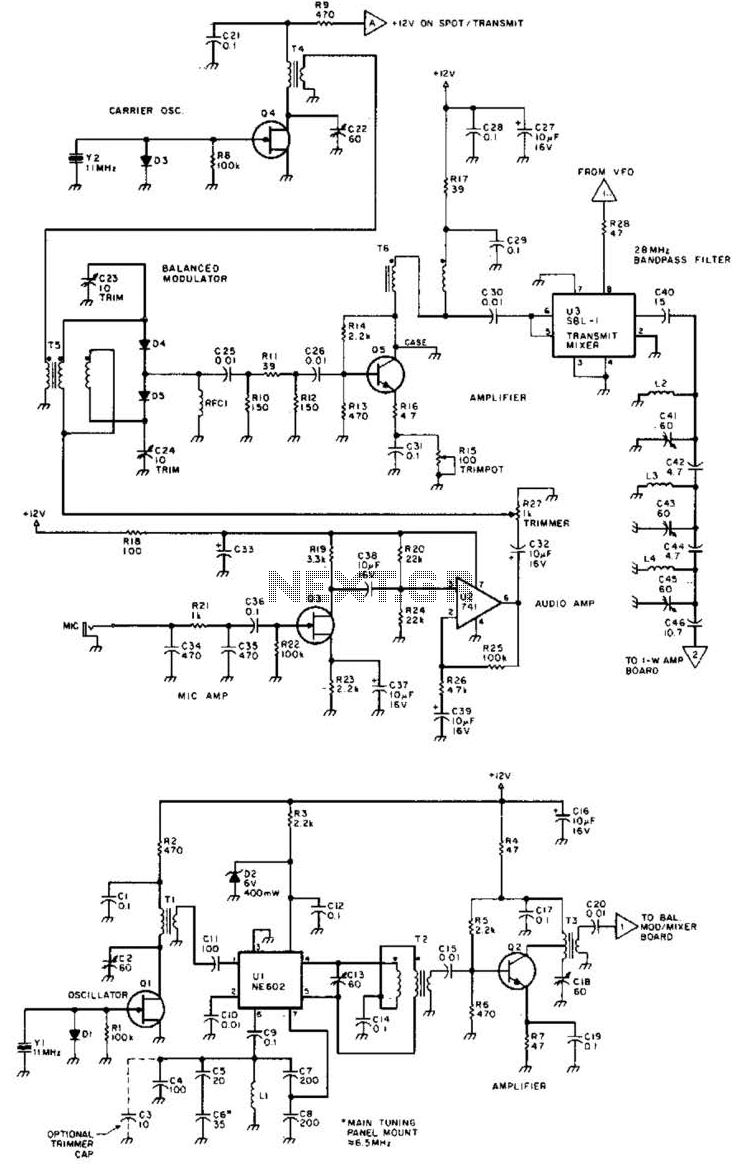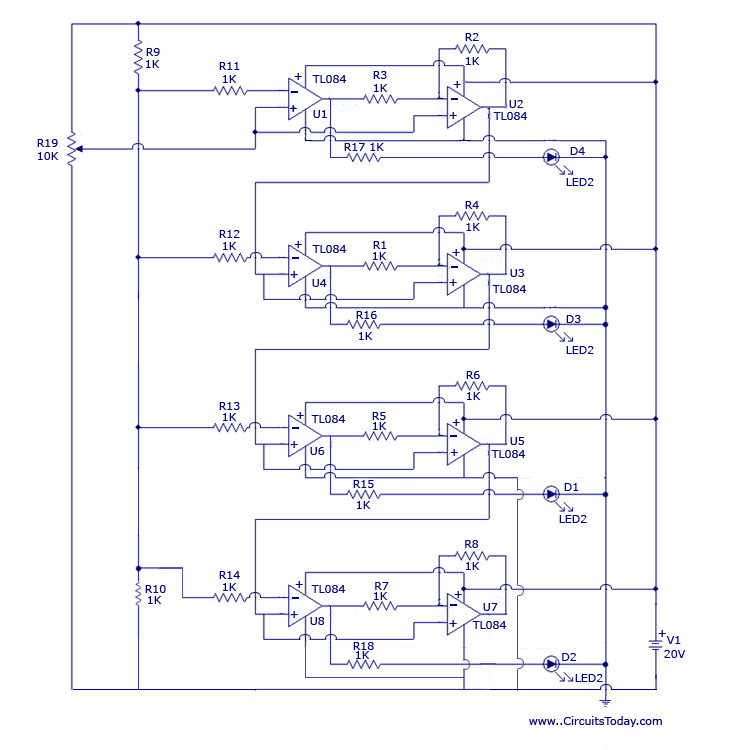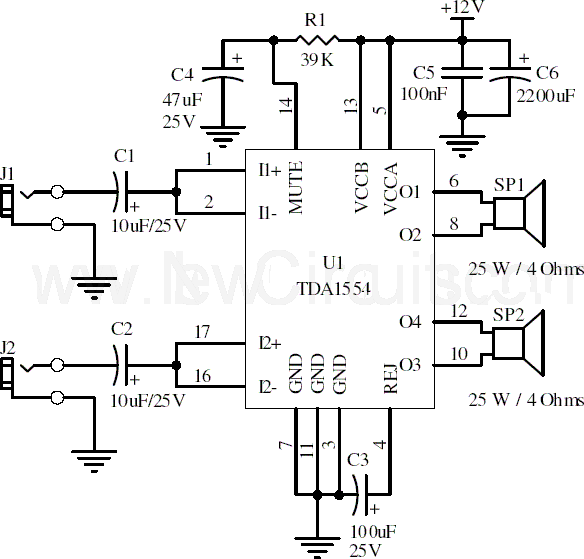
Electronic Locker Circuit
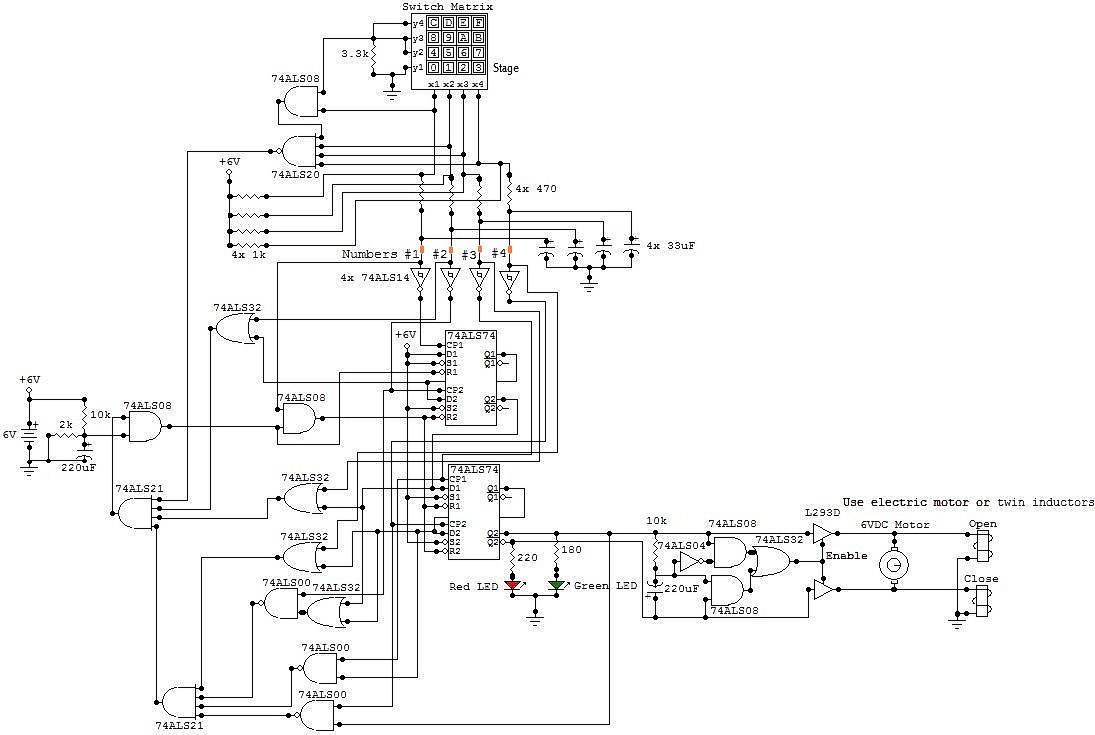
This circuit is an electronic locker controlled by a combination of switches (a code). It features a switch matrix located on the locker door, consisting of a unit of switches arranged in four rows and four columns, totaling eight terminals. When a switch is pressed, it establishes a connection between its corresponding column and row. This switch matrix is similar to those used in telephones, which are numbered from 0 to 9 and A to F, providing a total of 16 switches. To unlock the locker, four specific and different switches must be pressed in the correct order. For instance, if the code is 0, 1, 2, 3, pressing the sequence 0, 1, 2, 2, 3 will not open the locker. The desired code can be set during the circuit's construction. The designated line, referred to as "stage" in the schematic, is connected to ground and to one pin of a 3.3k resistor, while the other line connects to an input of the 7408 and the other pin of the resistor. All code numbers are located on the same line. To establish the order of the code numbers, the correct connection must be made between the node of the 7414 input and the appropriate node of the capacitor. For example, selecting the first line (y1) with the code 0, 1, 2, 3 means that the first number (#1) connects to the top left contact (x1), with switch 0 corresponding to x1/y1; these contact points are marked in orange in the schematic. When the locker is locked, a red LED lights up while the green LED remains off. Conversely, when the locker is opened, the red LED turns off and the green LED lights up. To lock the locker, any of the 16 switches on the matrix can be pressed. The locker is powered by a 6V source, preferably a rechargeable battery that lasts at least three full days, or alternatively, four 1.5V batteries connected in series, which last about five hours but are less costly. To conserve energy, the red LED can be omitted. When powered on, the locker remains locked. An electric motor or inductors are utilized to operate the door mechanism. When closing, the motor rotates counterclockwise for a set duration, moving a toothed bar down, then stops to keep the locker closed. When opening, the motor rotates clockwise for a set duration, moving the toothed bar up, then stops to keep the locker open. Alternatively, if inductors are used, the second inductor activates for a set duration to move a magnetic bar left, stopping afterward to keep the locker closed. When opening, the first inductor activates for a set duration to move the magnetic bar right, then stops to keep the locker open. The buffer (L293D) controlling the motor or inductors has two Vcc inputs and four ground connections; both Vcc inputs should be connected to +6V, while all ground connections should be linked to the circuit's ground. All circuit components are housed in a rack, except for the LEDs and the switch matrix, which are mounted on the door.
The electronic locker circuit is designed to provide secure access via a combination code entered through a matrix of switches. The switch matrix, configured in a grid format, allows for multiple switch combinations to be input, enhancing security by requiring specific sequences for unlocking. The use of the 7408 logic gate enables the processing of input signals from the switch matrix, ensuring that only the correct sequence results in a successful unlock.
The circuit's design incorporates visual feedback through the red and green LEDs, providing immediate indication of the locker’s status. This feature is essential for user interaction, allowing users to understand whether the locker is locked or unlocked without needing to open it. The choice of power supply is critical; a 6V rechargeable battery is recommended for its longevity and sustainability, making it suitable for frequent use.
The motor or inductors play a vital role in the mechanical operation of the locker door. The motor's ability to rotate in both clockwise and counterclockwise directions facilitates the locking and unlocking mechanism effectively. The toothed bar mechanism provides a reliable way to secure the door, ensuring it remains closed when locked and opens smoothly when unlocked. The use of inductors as an alternative allows for a different method of operation, utilizing magnetic attraction to control the door movement.
The L293D buffer is crucial for managing the power requirements of the motor or inductors, ensuring that the circuit operates safely and efficiently. Proper grounding and power connections are necessary to prevent malfunctions. The overall design emphasizes safety, reliability, and user-friendliness, making it an effective solution for electronic locking systems.This circuit is an Electronic Locker. It is controlled by a switches combination (by a code). There is a switch matrix on the door of the locker. This one is a unit of switches connected into 4 arranged of 4 columns for a total of eight terminals. When we press on a switch, this one establishes the contact between its column and its line. This swi tch matrix is also used in the telephones, for example. But it is numbered from 0 to 9 and from A to F for a total of 16 switches. To open the locker, we have to press 4 specific and different switches in the good order. If for example the code is 0, 1, 2, 3 and we press two times to the same switches: 0, 1, 2, 2, 3 the locker won`t open. In this circuit, the code is 0, 1, 2, 3 but we can set the desired code when we built de circuit. The desired line (called "stage" in the schematic) is connected to the ground and to a pin of the 3. 3k resistor and the other line is connected to an input of the 7408 and to the other pin of the resistor.
All the desired numbers of the code are in the same line. To set the order of the number of the code, we have to set the good connection between the node of the 7414 input and the appropriate node of the capacitor. For example, if we select the first line (y1) and the code is 0, 1, 2, 3 the first number (#1) is connected to the top left contact (x1).
The switch 0 is corresponding to x1/y1. These points of contact are colored in orange in the schematic. When the locker is locked, the red LED is turned on and the green LED is turned off. When the locker is opened, the red LED is turned off and the green LED is turned on. To lock the locker, we can push any of the 16 switches of the matrix. The locker is powered by a 6V source. I recommend using a 6V rechargeable battery because this one lasts a long time (at least 3 full days) and can be re-used. Otherwise, we can use four 1. 5V battery connected in serial. These least only 5 hours but are less expensive. To save energy, we can remove the red LED. When the locker is powered on, it is locked. The electric motor or the inductors close the door while a bit of time and after, stop working. When we open the locker, the electric motor or the inductors open the door while a bit of time and after, stop working.
To control the state of the door (open or lock) we can use an electric motor or a pair of inductors. If we use a electric motor, when the locker is closed, the motor turns in the anti-clockwise direction during a certain time and moves down a toothed bar. After this time, the motor stops turning and the locker remains closed. When the locker is opened, the motor turns in the clockwise direction during a certain time and moves up the toothed bar.
After this time, the motor stops turning and the locker remains opened. If we use two inductors, when the locker is closed, the second inductor works during a certain time and moves left a magnetic bar by attraction. After this time, the inductor stops working and the locker remains closed. When the locker is opened, the first inductor works during a certain time and moves right the magnetic bar.
After this time, the inductor stops turning and the locker remains opened. The buffer (L293D) who controls the motor or the inductors has two Vcc inputs and four ground connections. The both Vcc inputs must be connected to the +6V and all ground connections must be connected to the ground of the circuit.
All the parts of the circuits are placed in the rack except the DELs and the switch matrix which them, are placed on the door. 🔗 External reference
The electronic locker circuit is designed to provide secure access via a combination code entered through a matrix of switches. The switch matrix, configured in a grid format, allows for multiple switch combinations to be input, enhancing security by requiring specific sequences for unlocking. The use of the 7408 logic gate enables the processing of input signals from the switch matrix, ensuring that only the correct sequence results in a successful unlock.
The circuit's design incorporates visual feedback through the red and green LEDs, providing immediate indication of the locker’s status. This feature is essential for user interaction, allowing users to understand whether the locker is locked or unlocked without needing to open it. The choice of power supply is critical; a 6V rechargeable battery is recommended for its longevity and sustainability, making it suitable for frequent use.
The motor or inductors play a vital role in the mechanical operation of the locker door. The motor's ability to rotate in both clockwise and counterclockwise directions facilitates the locking and unlocking mechanism effectively. The toothed bar mechanism provides a reliable way to secure the door, ensuring it remains closed when locked and opens smoothly when unlocked. The use of inductors as an alternative allows for a different method of operation, utilizing magnetic attraction to control the door movement.
The L293D buffer is crucial for managing the power requirements of the motor or inductors, ensuring that the circuit operates safely and efficiently. Proper grounding and power connections are necessary to prevent malfunctions. The overall design emphasizes safety, reliability, and user-friendliness, making it an effective solution for electronic locking systems.This circuit is an Electronic Locker. It is controlled by a switches combination (by a code). There is a switch matrix on the door of the locker. This one is a unit of switches connected into 4 arranged of 4 columns for a total of eight terminals. When we press on a switch, this one establishes the contact between its column and its line. This swi tch matrix is also used in the telephones, for example. But it is numbered from 0 to 9 and from A to F for a total of 16 switches. To open the locker, we have to press 4 specific and different switches in the good order. If for example the code is 0, 1, 2, 3 and we press two times to the same switches: 0, 1, 2, 2, 3 the locker won`t open. In this circuit, the code is 0, 1, 2, 3 but we can set the desired code when we built de circuit. The desired line (called "stage" in the schematic) is connected to the ground and to a pin of the 3. 3k resistor and the other line is connected to an input of the 7408 and to the other pin of the resistor.
All the desired numbers of the code are in the same line. To set the order of the number of the code, we have to set the good connection between the node of the 7414 input and the appropriate node of the capacitor. For example, if we select the first line (y1) and the code is 0, 1, 2, 3 the first number (#1) is connected to the top left contact (x1).
The switch 0 is corresponding to x1/y1. These points of contact are colored in orange in the schematic. When the locker is locked, the red LED is turned on and the green LED is turned off. When the locker is opened, the red LED is turned off and the green LED is turned on. To lock the locker, we can push any of the 16 switches of the matrix. The locker is powered by a 6V source. I recommend using a 6V rechargeable battery because this one lasts a long time (at least 3 full days) and can be re-used. Otherwise, we can use four 1. 5V battery connected in serial. These least only 5 hours but are less expensive. To save energy, we can remove the red LED. When the locker is powered on, it is locked. The electric motor or the inductors close the door while a bit of time and after, stop working. When we open the locker, the electric motor or the inductors open the door while a bit of time and after, stop working.
To control the state of the door (open or lock) we can use an electric motor or a pair of inductors. If we use a electric motor, when the locker is closed, the motor turns in the anti-clockwise direction during a certain time and moves down a toothed bar. After this time, the motor stops turning and the locker remains closed. When the locker is opened, the motor turns in the clockwise direction during a certain time and moves up the toothed bar.
After this time, the motor stops turning and the locker remains opened. If we use two inductors, when the locker is closed, the second inductor works during a certain time and moves left a magnetic bar by attraction. After this time, the inductor stops working and the locker remains closed. When the locker is opened, the first inductor works during a certain time and moves right the magnetic bar.
After this time, the inductor stops turning and the locker remains opened. The buffer (L293D) who controls the motor or the inductors has two Vcc inputs and four ground connections. The both Vcc inputs must be connected to the +6V and all ground connections must be connected to the ground of the circuit.
All the parts of the circuits are placed in the rack except the DELs and the switch matrix which them, are placed on the door. 🔗 External reference
Warning: include(partials/cookie-banner.php): Failed to open stream: Permission denied in /var/www/html/nextgr/view-circuit.php on line 713
Warning: include(): Failed opening 'partials/cookie-banner.php' for inclusion (include_path='.:/usr/share/php') in /var/www/html/nextgr/view-circuit.php on line 713
